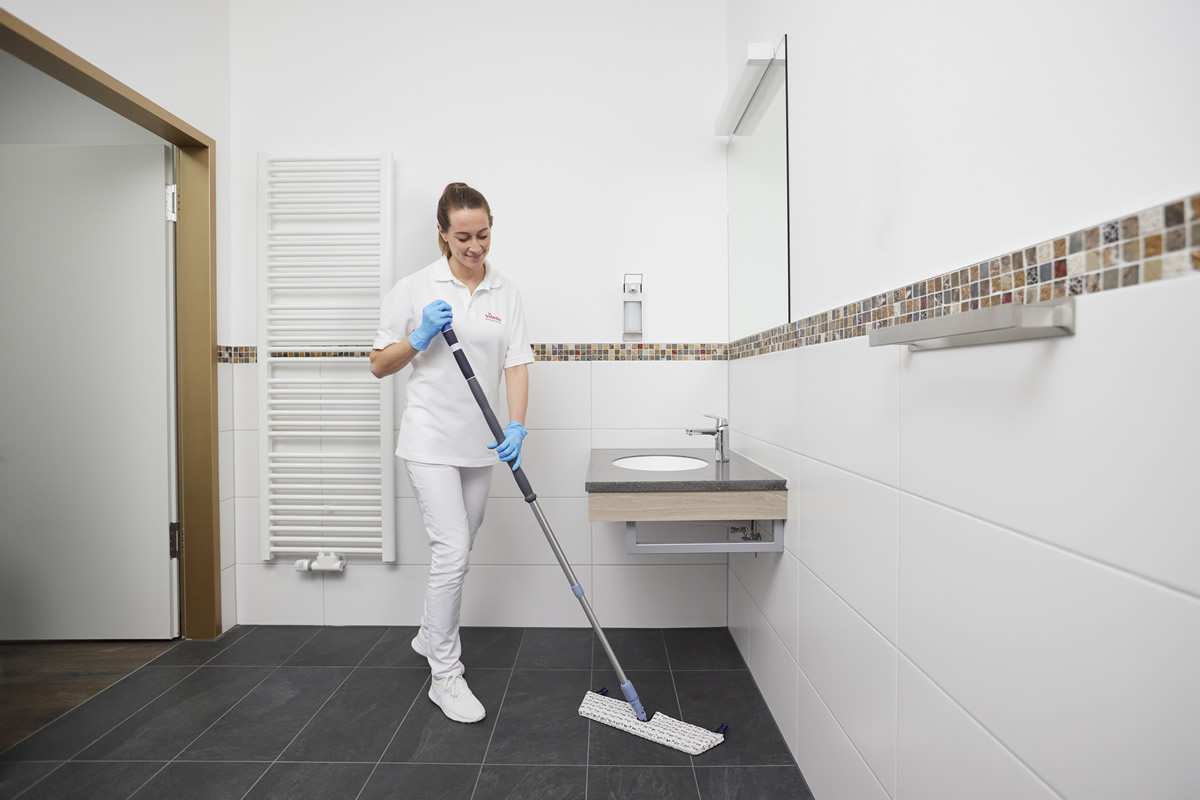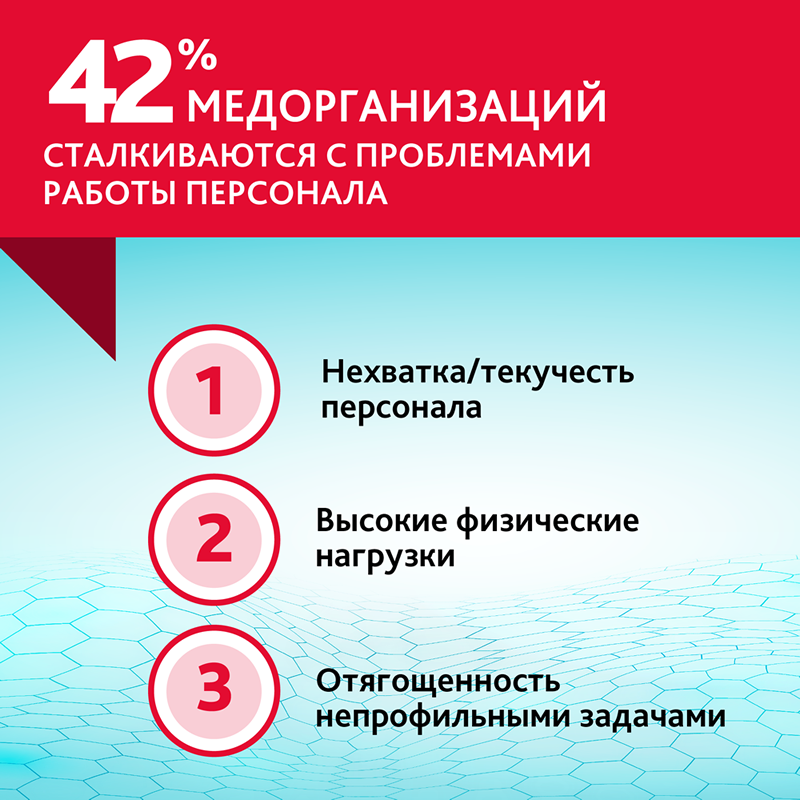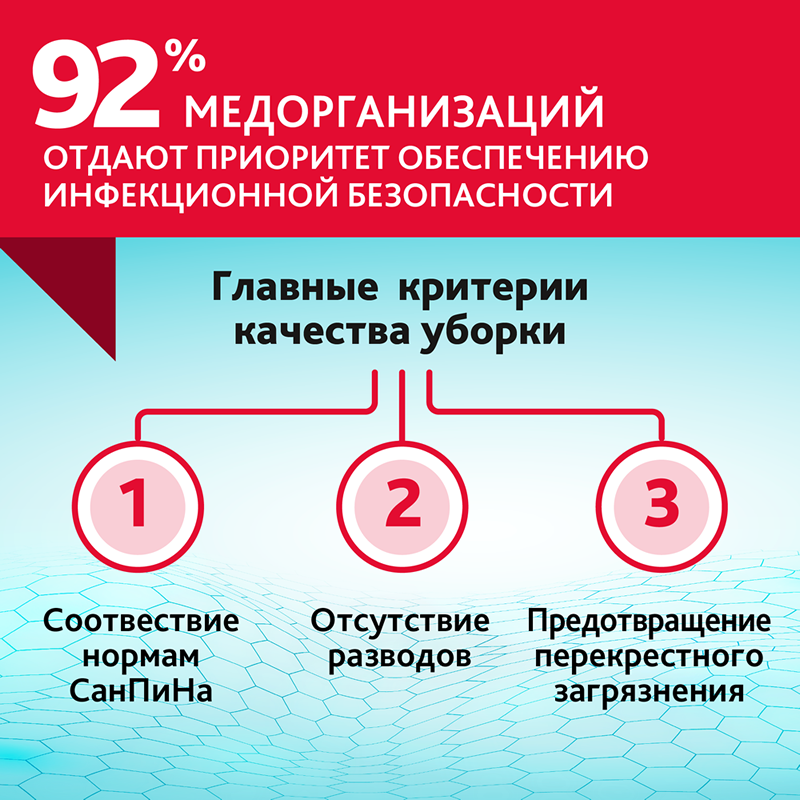
67% of medical institutions face problems when organizing cleaning
The Vileda Professional company conducted a survey of representatives of Russian medical institutions to find out how satisfied they are with the quality of cleaning, whether they are ready to introduce new cleaning technologies and whether cleanliness affects the image of medical institutions. Despite relative satisfaction with the level of hygiene, 67% of medical institutions stated that they face problems when organizing cleaning.
Main focus on epidemiological safety

Medical institutions began to monitor cleanliness and hygiene more closely after the COVID-19 pandemic. 92% of managers now give priority to infection safety when organizing business activities. The study showed what changes have occurred in the organization of harvesting processes:
- the frequency of cleaning has increased (88%) and the time spent on cleaning (70%);
- control over the quality of its implementation has increased (87%);
- the cost of purchasing detergents and disinfectants has increased funds (77%).
TOP-3 problems in cleaning medical institutions
96% of study participants are to one degree or another satisfied with the quality of cleaning in their medical institution, but at the same time67% face various problems when organizing cleaning. The TOP 3 includes: worn-out cleaning equipment, high consumption of detergents and disinfectants and lack of staff.
“Regulatory documents do not contain specific recommendations on how the harvesting process should be organized; only general requirements are described. Therefore, each medical organization independently chooses which equipment and cleaning method to use. For the purpose of illusory cost savings, many institutions use traditional methods, buying outdated equipment of poor quality, which often breaks down and requires replacement. All this in the future leads to increased costs for equipment, even greater consumption of detergents and disinfectants and negatively affects the quality of cleaning and infection safety,” says Evgenia Gushchina, national manager in the Healthcare segment b>ViledaProfessional Russia.
The “eternal” problem with personnel< /h2>
42% of representatives of medical institutions face various problems with the work of cleaning staff. The TOP 3 problems include: shortage or turnover of staff, high physical activity and the need for employees to perform duties of junior medical staff in addition to cleaning.
In many institutions, the same problem exists: an outdated labor organization system, when junior medical staff staff performs all activities. Employees are engaged in transportation, accompanying patients, care, feeding, issuing clothes and linen and cleaning, which is carried out on a residual basis, leaving very little time and effort for it.
“Basically, orderlies are transferred to cleaners: often only their job title changes, but the functionality remains the same. At the same time, they cease to be medical personnel and lose the corresponding benefits and salary bonuses,” comments Evgenia Gushchina
But there is already a fundamentally new view on the reorganization of personnel – the separation of medical and economic activities. Some of the junior staff in the position of orderly or nurse remain in “heavy” departments, where their presence is justified, and help in caring for patients, and some are transferred to the cleaning service in the cleaning department or to a specialized unit with broader functionality. Junior medical staff continue to care for the patient, and auxiliary economic functions are taken over by groups of employees: a cleaning group, a group of housekeepers, a group of transporting and accompanying patients, a group of food services. The cleaning team can be staffed with existing staff without increasing the number of junior staff, or staff can be reduced by introducing high-performance cleaning equipment. Thus, fewer personnel will be able to carry out high-quality cleaning over much larger areas without increasing physical activity.
Assessing the quality of cleaning

When assessing the quality of cleaning, representatives of medical institutions most often noted the following criteria: compliance of cleaning with SanPin standards (98%), absence of stains (75% ), prevention of cross-contamination (74%).
To objectively assess the quality of cleaning, it is necessary to use a combination of methods – visual, instrumental (UV tags), bacteriological (culture of swabs), digital (electronic cleaning log with control results) .
What do patients say about cleaning?
The media analytical agency Ex Libris, at the request of Vileda Professional, monitored reviews of medical institutions on review sites over the past year. Most often, patients complain about dirty toilets and floors. The most negative reviews related to cleaning are noted in Moscow, Moscow, Leningrad regions, Novosibirsk and Sverdlovsk regions.
What should cleaning be like?
As the results of the study showed, from 62% to 68% of managers of medical institutions pay attention to the efficiency, speed, innovation and productivity of the cleaning process. These requirements are reflected in the federal project “Lean Clinic”, which is aimed at increasing the efficiency of medical organizations, optimizing costs, and introducing more effective methods and technologies.
The transition to modern and safe cleaning methods would help medical institutions reduce costs and improve the quality and epidemiological safety of the cleaning process. One such method is the bucketless harvesting method. 75% of employees of medical institutions who use traditional or bucket cleaning methods are interested in introducing innovations in cleaning.
“There are now many different proposals for bucketless cleaning methods. But not all of them are aimed at reducing costs and properly organizing processes. It is very important to pay attention to the integrated approach of cleaning system manufacturers. Cleaning has become much more than just inventory. These are services, proper organization of washing and material processing processes, placement of personnel in cleaning areas, training, digital quality control of cleaning. Cleaning should become a manageable process. When processes work like clockwork, the focus of medical institutions becomes even stronger on providing medical services of higher quality,” says Evgenia Gushchina.
Important !The information is provided for reference purposes.
